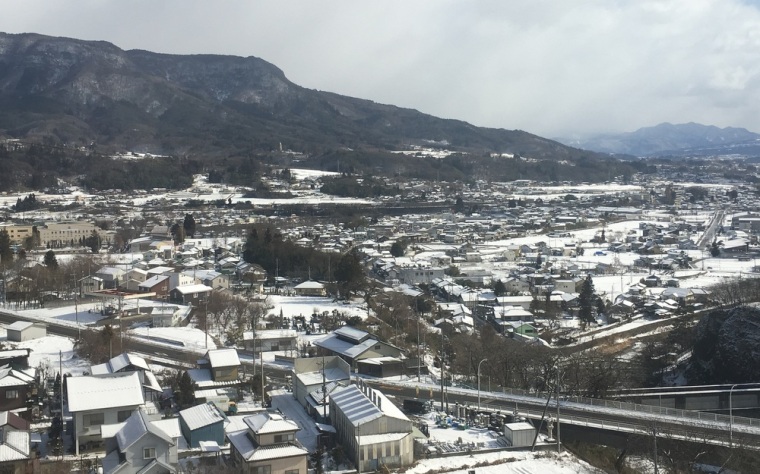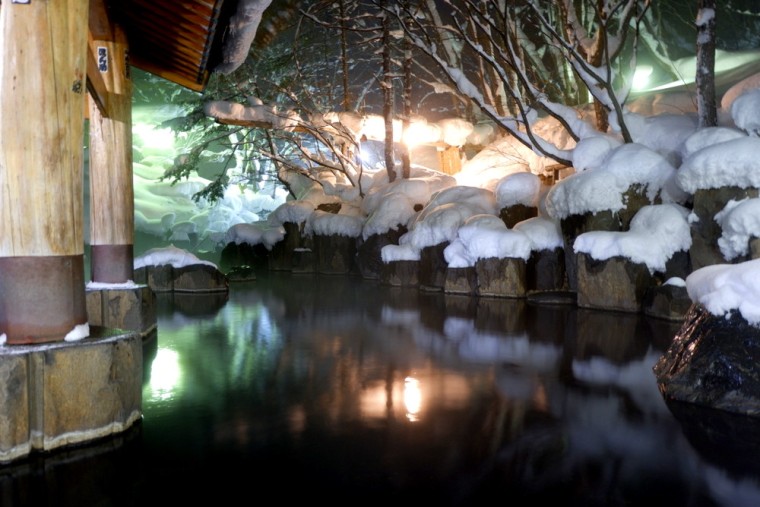Being the volcanically-active country it is, Japan is teeming with natural hot springs. Though these onsen are everywhere from cities to the seaside, the best ones are always found in the mountains, in my opinion. There are few things more relaxing than soaking in an outdoor onsen (rotenburo) alongside a river in the middle of a forest. I’ve only had this experience once before – at Kurokawa Onsen in Kyushu. For another onsen to top that one, it would have to have something extraordinary.
On a chilly Saturday in January, I hopped on the shinkansen with some friends and headed north to Gunma. It had been snowing in Tokyo, but we were still excited to look out the window and see the landscape gradually get whiter and whiter. Roughly 150km and 75 minutes later, we arrived at Jomo-Kogen Station, where there’s really not much besides a delicious udon/soba shop called Tenmaru. Naturally, we were the first ones out of the station, and the first ones in the restaurant!








We were picked up by our ryokan’s shuttle bus and driven an hour down a winding, mountain road. The further we went, the deeper the snow became and it wasn’t long before everything in front of the windshield was completely white. We passed by multiple small ski resorts and the frozen waters of Fujiwara Dam which looked eerie under a blanket of fog and snow. Finally, we were greeted by a mammoth wooden gate marking the entrance to our destination. I was in awe of the amount of snow, but little did I realise the beauty that awaited us just a few hundred metres away.
The buildings at Osenkaku are typical of a traditional ryokan in Japan – mostly made of wood, quite cold and a little dated. The oldest part of the ryokan was built in the 1930s. The corridors are frigid but fortunately, the guest rooms are very comfortable. We got lucky with a spacious corner room with windows on two sides. And the best part was the heated tatami mats! This meant anything we left on the floor – jackets, socks, mittens – were all nice and warm when we put them back on. It also meant our futons stayed toasty all night. I would love to have heated tatami in my apartment in Tokyo!





It didn’t take us long to step back outside into the snow, eager to explore the area. There are four rotenburo located across the bridge and downstream; three baths are for both guys and girls, and one is for ladies only. From spring to autumn, I’m sure the yukata provided by the ryokan would suffice, but winter is a whole different story. Even the yukata jacket did nothing to stop the chill. But, as yukata and rotenburo go hand in hand, we did brave the cold for a few photos at one point!
My first thought upon seeing Takaragawa Onsen’s rotenburo was just ‘wow!’. I was honestly speechless. Remember how I said that only something extraordinary could top Kurokawa Onsen… well, I realised what that was: SNOW! It was not just the volume of snow, but the pure-white colour and the graceful, soft shapes it had created throughout the landscape. The Takaragawa River rushed right down the middle of the four rotenburos, carrying ice-cold water from the mountains. It’s always strange to see naturally freezing and boiling water side by side like this.




With the sun quickly slipping away, we chose the biggest mixed bath to take a dip in. Since there were a lot of guys around, we were thankful for the special onsen robes, but I have to say the facilities were pretty unimpressive. Imagine getting naked – and later trying to dry off – in a tiny concrete room in freezing temps. If there’d only been a couple of people there it would have been OK, but the flimsy door was continually being opened and closed, each time letting in a gush of cold air as well as giving the guys outside a view of ladies getting changed! Not the most comfortable situation.
The women’s bath, on the other hand, was so much better. The change room was large and private, the water felt hotter, and we didn’t have to bother with the onsen robe since only women were allowed. The bath was surrounded entirely by walls of snow, with two atmospheric stone lanterns at the far end. THIS was the relaxing onsen experience I had wanted!





By dinnertime, we’d worked up quite the appetite. The food in the ryokan’s restaurant was delicious. We all got our own hot pot and assortment of sashimi. We also had a buffet to choose from. The most eyebrow-raising dish was definitely the bear soup. Made from bear meat, it’s said to be very nutritious and has been a local delicacy for many years in this part of Japan. It had a peculiar smell but I thought it was tasty and would definitely have it again!
After a solid night’s sleep, we were up early the next morning. The sun was out and the sky was the most beautiful light blue. All the fresh snow from the previous day looked magical under the sunlight. The name of the river, Takaragawa, translates as a ‘river of treasures’ and in that moment, I felt like we’d truly struck gold.





It’s not known when this place was first discovered. Being in such a remote location, I’m sure for many hundreds of years it went unnoticed, and perhaps it was even longer before any structures were built. Traces of the Jomon people have apparently been found in the area, so it’s possible that the onsen was used in the Jomon Period (~300BC).
The onsen as it is today became a modern ‘destination’ in the early 1900s at which time people had to walk all the way from Minakami town. After WWII, roads were built, electricity was installed and the ryokan really started to take off. It’s now very popular among foreign tourists as it’s easy to get to from Tokyo and seems to be advertised a lot on international holiday websites. There seem to be more foreign guests than Japanese, but I can’t blame them – who wouldn’t want to come and experience this hidden winter paradise! How about you?!










It looks like you did find a treasure! Your photos are lovely, and this looks like a prefect place to enjoy an onsen while being surrounded by pretty views.
LikeLiked by 1 person
Thanks Jennifer! Such a stunning, hidden gem! Do you have a favourite onsen??
LikeLike
I don’t know if I have a favourite. Onsens are a bit too hot for me. But I have been to Gero with my husband, and it was really nice.
LikeLiked by 1 person
Looks like a fairytale setting and sounds like a great way to spend a weekend.
John
LikeLike
Thanks John. It was great – just not long enough!!
LikeLike
Your description and the photos of Takaragawa Onsen are fantastic! Winter at its best, and not so far from Tokyo!
LikeLiked by 1 person
Thanks Hien! Definitely an easy weekend destination for people based in Tokyo.
LikeLike
I don’t know why I find snow pictures in Japan so appealing–because when I look out my window, I don’t seem to see the same thing. Maybe it’s your photographic skills.
Beautiful pictures. It seems like you had an amazing time.
LikeLike
Thanks Anthony :) I know what you mean. Even in Hokkaido where the snow is metres high it still looks so beautiful. I don’t know what it is either!
LikeLiked by 1 person
The soft pillows of snow transform the buildings and river into a magical fairyland. Thanks for sharing your discovery with us, Celia!
LikeLike
Perfect description, Eliza. That’s exactly how it felt! I hear autumn is good time to go too, and I’m sure it would be a totally different experience.
LikeLiked by 1 person
Wonderful. Beautiful and real winter, which we have in Finland – only reindeers are missing. :)
LikeLike
Haha, if only we had reindeers! Then it would truly be a fairytale, as I imagine Finland to be!
LikeLiked by 1 person
I heard that snow in Japan is more powdery and soft than in other places. But wow! Judging from your photos it also seems to be the most beautiful! It’s incredible how even in Japan nature seems to be dictated by the principle of elegant simplicity the Japanese are known for.
LikeLike
Great observation :) Perhaps the culture was influenced by nature! I feel the same with cherry blossoms and Japanese maples… they blend so beautifully with the culture and traditions and are a big part of everyday life.
LikeLiked by 1 person
This was such a special trip, and I was so happy to be there with you two <3
LikeLike
Thanks for organizing it!! Can’t wait to spend cherry blossom season together with you guys x
LikeLiked by 1 person
Ooo, I’m putting this on my list for next winter! The nighttime photos are especially nice.
LikeLike
Yes, please do!! Such a wonderful place. Try go on a weekday if you can!
LikeLike
Great article, thanks for sharing. I love the whole bathing culture in Japan! https://mrmatthewruddle.com/2017/10/02/naked-in-japan/
LikeLike
Thanks, Matthew! Great post you have too – love the comment that taking a bath is like going to the pub… that’s so true!
LikeLiked by 1 person
thanks!
LikeLike
This looks so cool! Japan is on my must visit list so I will be adding these hot springs too! Thank you for sharing your adventure!
LikeLike
You won’t regret it! Hope you can visit Japan soon. Come during the cherry blossom season if you can! :)
LikeLiked by 1 person
OMG! I so want to go here!!!!!! It looks like a magical sanctuary
LikeLike
It was so amazing. I’ve been to the snow many times for skiing but never just for onsen like this. Highly recommend it!
LikeLike